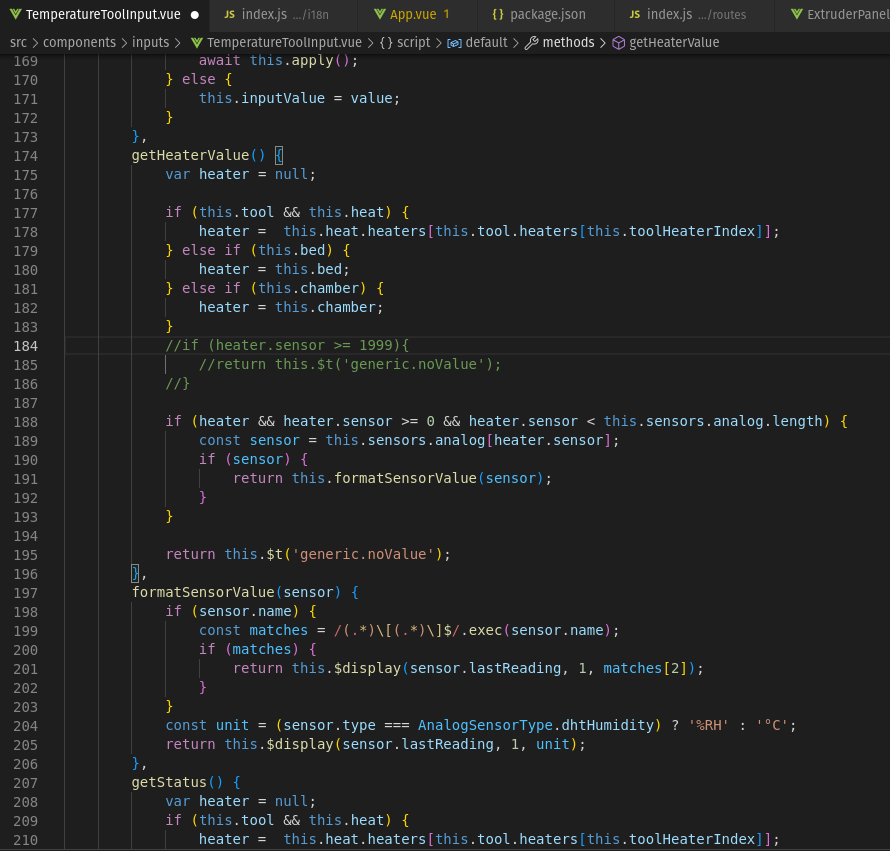@chrishamm I isolated the problem to be specific to only one of our machines. So it's not firmware related, the problem is on our end 
Best posts made by Hugsy
-
RE: mDNS fix works on RRF3.4.5 but not on RRF3.5b4posted in Beta Firmware
-
RE: High Temperature Extruder w/o water-coolingposted in 3D Printing General Chat
@JRCL Funmat and Creatbot probably use a modified PEEK that needs annealing. In any case, the best practice is to focus on chamber temperature uniformity before going after high temps.
-
RE: Why ?posted in Firmware wishlist
@Herve_Smith If you compile your own DWC, changing the countdown from a few seconds to zero is actually quite easy. It's the" countdownSeconds" variable in src/components/dialogs/ResetHeaterFaultDialog.vue
-
RE: Display "No sensor" instead of 2000°C, can't find a working fixposted in Duet Web Control
@Phaedrux I actually did it by adding the lines 205 to 207 here :

We're working on DWC3.4.5 but we can also have it work on 3.5
-
RE: Enabling fan tach on expansion board causes fan to disappearposted in Firmware installation
@dc42 Thanks! It works perfectly now
Latest posts made by Hugsy
-
RE: Why ?posted in Firmware wishlist
@Herve_Smith If you compile your own DWC, changing the countdown from a few seconds to zero is actually quite easy. It's the" countdownSeconds" variable in src/components/dialogs/ResetHeaterFaultDialog.vue
-
RE: Display "No sensor" instead of 2000°C, can't find a working fixposted in Duet Web Control
@Phaedrux I actually did it by adding the lines 205 to 207 here :

We're working on DWC3.4.5 but we can also have it work on 3.5
-
RE: Display "No sensor" instead of 2000°C, can't find a working fixposted in Duet Web Control
Sorry I forgot to mention that this code section is normally in ToolPanel.vue line 491
-
Display "No sensor" instead of 2000°C, can't find a working fixposted in Duet Web Control
Hi,
I'm trying to have DWC display a message instead of 2000°C ("n/a" in this example), here is the fix I tried to implement but nothing seems to work, it keeps displaying 2000°C when the sensor is disconnected.
Does anybody have an idea of what I'm doing wrong here?My fix is are the commented lines 184 to 186 :

Thanks in advance,
Hugues
-
RE: Temperature controlled LED displayposted in Gcode meta commands
I strongly advise to not put any M98 inside daemon.g as it can disrupt the main DDARRing and cause stutter in the movement. What I usually do is copy the macro inside the daemon.g and even then some commands might disrupt the movement, at least not the whole macro will cause problems. Maybe we can queue the commands in a different G-Code queue with RRF3.5 to avoid all of this.
-
RE: mDNS fix works on RRF3.4.5 but not on RRF3.5b4posted in Beta Firmware
@chrishamm I isolated the problem to be specific to only one of our machines. So it's not firmware related, the problem is on our end

-
RE: mDNS fix works on RRF3.4.5 but not on RRF3.5b4posted in Beta Firmware
@chrishamm Weird, maybe I need to update DWC as well? All my duet3D-firmware modules are updated I don't see why it wouldn't work. I'm trying to find what broke during my merge with 3.5-dev.
I'm struggling to install avahi correctly so I'll try to find something else to test the mDNS.
-
mDNS fix works on RRF3.4.5 but not on RRF3.5b4posted in Beta Firmware
Hi,
I saw the mdns fix at this commit and copied it into my current RRF3.4.5 branch and it works!
Now with RRF3.5b4 where it's already implemented, when I upgraded my MB6HC to it, saldy my mac doesn't get it with the mDNS even tho it worked on RRF3.4.5 with the fix.An I missing something? Does anybody have the same issue? Did something else changed regarding networking in RRF3.5?
Thanks in advance,
Hugues -
RE: High Temperature Extruder w/o water-coolingposted in 3D Printing General Chat
@JRCL I don't think it would be a great idea to anneal inside the machine itself since that would mean temperatures beyond 150°C, I'm not familiar with these materials though. If you have a chamber that can go high enough with a good temperature uniformity, printing a non-modified PEEK can be an idea but it is a nightmare to print anyways. For high temperature applications with FDM I tend to recommend Ultem 1010 or 9085. PEEK is better but it's more aimed towards high chemical resistance, mechanically it won't be better if it's not printed correctly.
-
RE: High Temperature Extruder w/o water-coolingposted in 3D Printing General Chat
@JRCL Funmat and Creatbot probably use a modified PEEK that needs annealing. In any case, the best practice is to focus on chamber temperature uniformity before going after high temps.